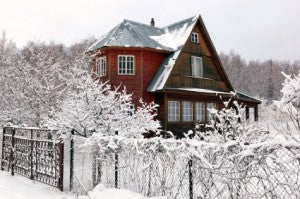
The minute winter is over and the temperature creeps up above 40 degrees, I know exactly what I’m supposed to do. Spring cleaning? Bring it on. Paint touch-ups? Love it. Garden prep? Couldn’t start soon enough. But somehow I’m never as enthusiastic about my preparations for winter. Maybe it’s because I’m too wrapped up in
Jingle Bells to think about the important, practical things (like my house making it through the stormy season). So this year, I’m mending my ways. Amid all my plans for caroling and drinking eggnog, I hereby commit to winterize my home. You all heard me, right? Somebody’s got to hold me to it…
If you’re in a similar situation, there are plenty of places to look for good tips and checklists. I’ve listed some of the best at the end of the post, but most of the advice shakes down into these three basic categories:
1.
Energy efficiency
In most parts of the country, winter is the season of skyrocketing utility bills, as we pay to
heat our rooms, our water, and our toes. Reduce costs by checking the basics first: open heat vents, make sure your insulation is up to snuff, and check doors and windows for heat leaks—a little caulking or a weather strip is far cheaper than the fuel it takes to raise your home’s temperature those few, critical degrees! Another clever trick I found is to reverse the direction of your ceiling fans, if you have them, pushing the heated air downward and keeping the room warmer.
2.
Seasonal use items
Winter means putting certain things away and pulling out others that haven’t seen the light of day in nine months. Make sure the former are stored properly and the latter are in good repair for winter use. For example, drain lawnmowers and weed-eaters of gasoline to keep the engines from gumming up in the cold. Remove window-unit air conditioners, or winterize central AC units by draining water pipes and covering the unit with plastic.
Before the weather turns really nasty, have the chimney cleaned and/or the furnace serviced. Stock up on your supply of firewood or pellets, if you use a traditional fireplace or wood stove. And make sure snow shovels, ice scrapers, and snow blowers are all functional and accessible.
3.
Storm and cold prep
Winter weather can be pretty brutal on your home and property. You can’t anticipate everything, but you can prepare. Here are some common problems and troubleshooting tips.
Heavy rain or snow – Clean gutters and unclog downspouts. Gutters weighty with debris and water can pull away from the siding or (worse) leak into the house. Similarly, replace worn shingles on the roof before you have to fix a leak.
Ice – Drain sprinklers and hoses, insulate outdoor faucets, and turn off the outdoor water supply to prevent frozen or cracked exterior pipes. Keep sand, salt, or ice melt on hand to keep porch steps and walkways safe in freezing temperatures.
Wind – Check trees close to your house for rot or overhanging branches that could come off in a windstorm (or heavy snow). Cover and store patio furniture and stash pots and planters in the shed or garage.
Most of all, don’t forget your
emergency kits! Double check your supply of
candles and
blankets, in case of power outages, or invest in a
Yeti Solar Generator to keep the basics powered in case of a blackout. Make sure you have the needed supplies to help you weather any storm.
Don't forget to
Winterize your Car too! Check out these links for handy checklists, and stay safe and warm this winter!
•
http://www.realestate.com/advice/a-checklist-for-winterizing-and-weatherproofing-your-home-66175/
•
http://www.bobvila.com/articles/502-winter-preparation-checklist/
•
http://www.doityourself.com/stry/winter-home-checklist#b
•
http://www.artofmanliness.com/2010/11/09/15-ways-to-winterize-your-home/


4 comments
R A Myers
Gasoline: Use and replace stored and in equipment gasoline (generator, snow removal equipment). Add gas line antifreeze to in equipment tanks, including autos, etc. Keep auto and generator tanks full to reduce condensation.
Barbara Elsbury
We live in a all electric home, and on a country lane. Two years ago we were hit by an ice storm (rare for Texas) and lost all power. No lights, no heat, no way to cook. We were without these essentials for six days. We had much stored food, and oil lamps, but were still in a bind. The rescue trucks had to be rescued. Three of them. The next spring we invested in a small wood burning fire stove, with a cook grill built into the top, and two cords of wood. Come on ice and snow…We are set.
David
1. Water lines if cpv or cpvc get a piece and a can of primer and a can of glue and fix it yourself. Also multiple quarter turn shutoffs are very handy.
2. Get a gas grill and keep a couple of extra propane tanks for emergency cooking.
Rick
Excellent ideas! I wish more people would think about the winter before something happens. A few additions: test your heating system-make sure everything heats before the frigid weather arrives. Also, those programmable thermostats that turn the heat down automatically, are the number 2 cause of frozen pipes. By the time it takes for the room to drop from 70* to 60*, the pipes can drop below freezing-even if the rooms are still warm! If your pipes do freeze, they will eventually split, but they won’t leak – until they thaw! Turn off the water as soon as you realize they’re frozen, and you might save thousands in water damage repairs. Above all, be prepared! And make sure you have your emergency kits ready. One single ice storm can knock power out for days, freezing pipes, leaving you in the dark- cold, and with no way to heat dinner. Welcome to winter. Be prepared!